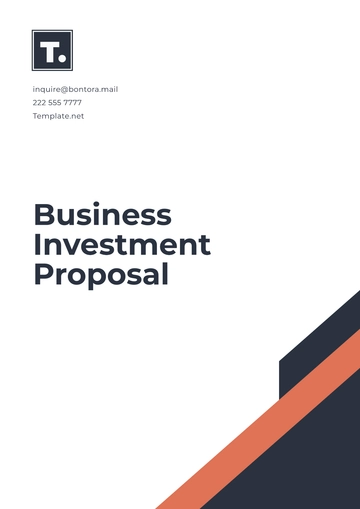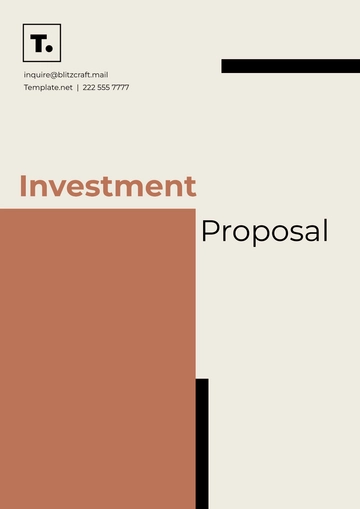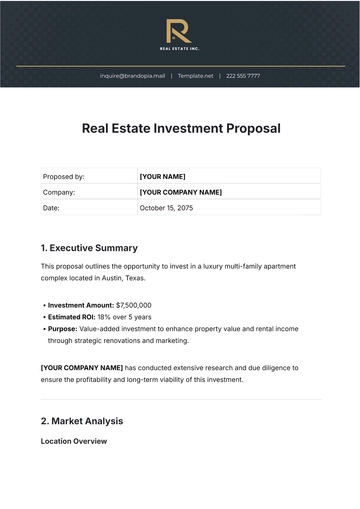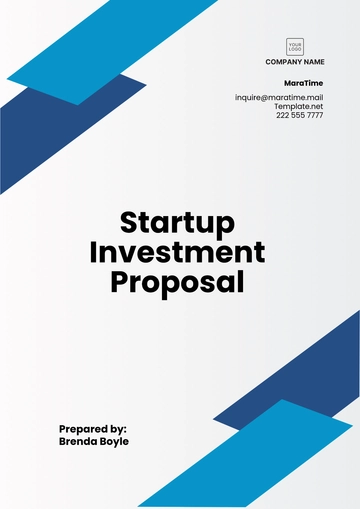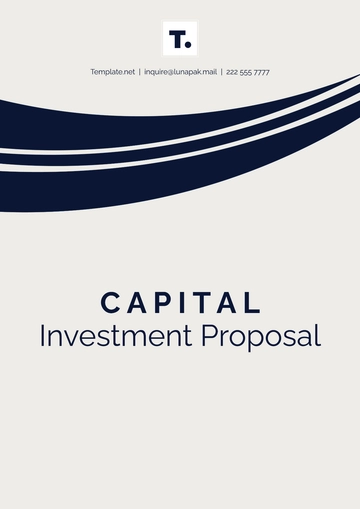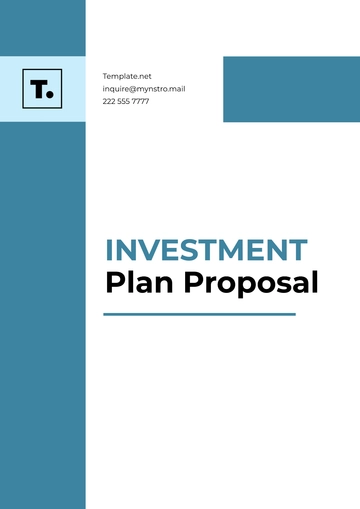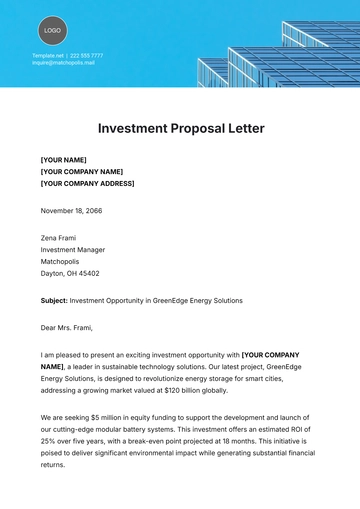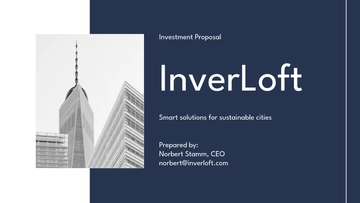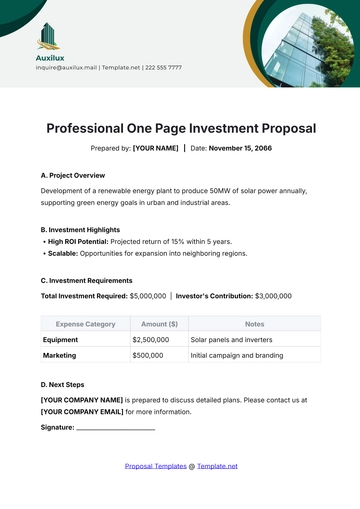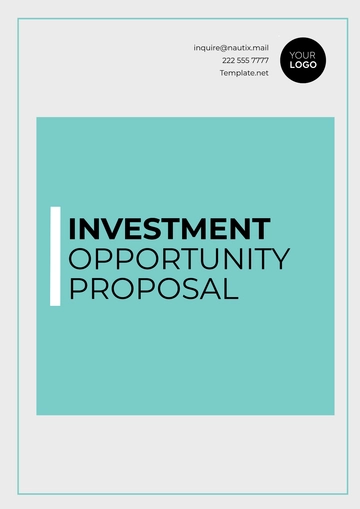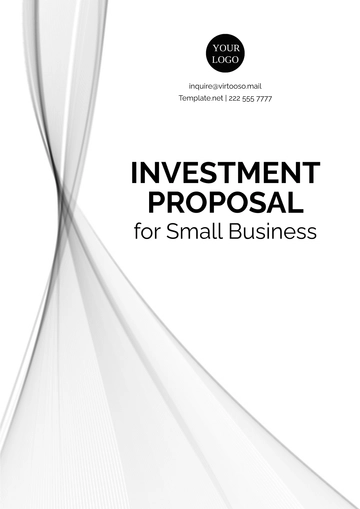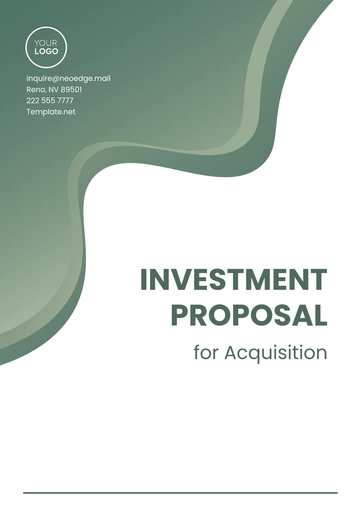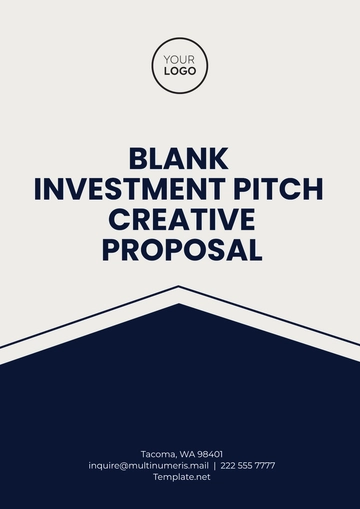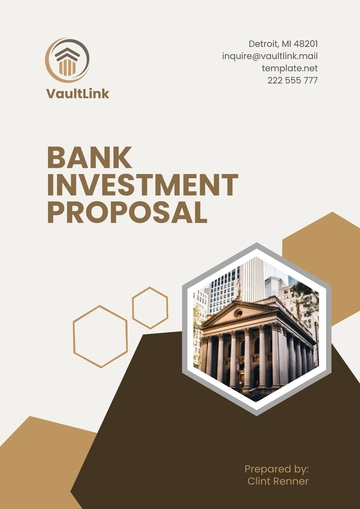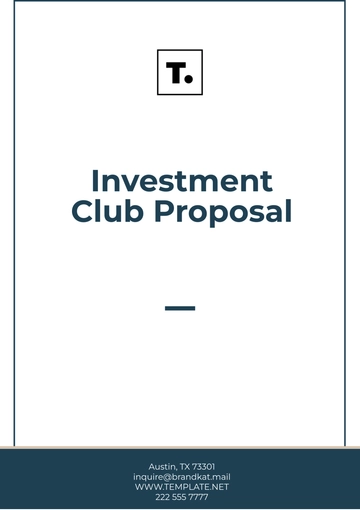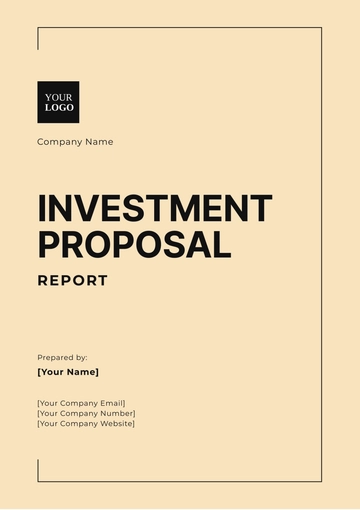Free Gym Investment Proposal
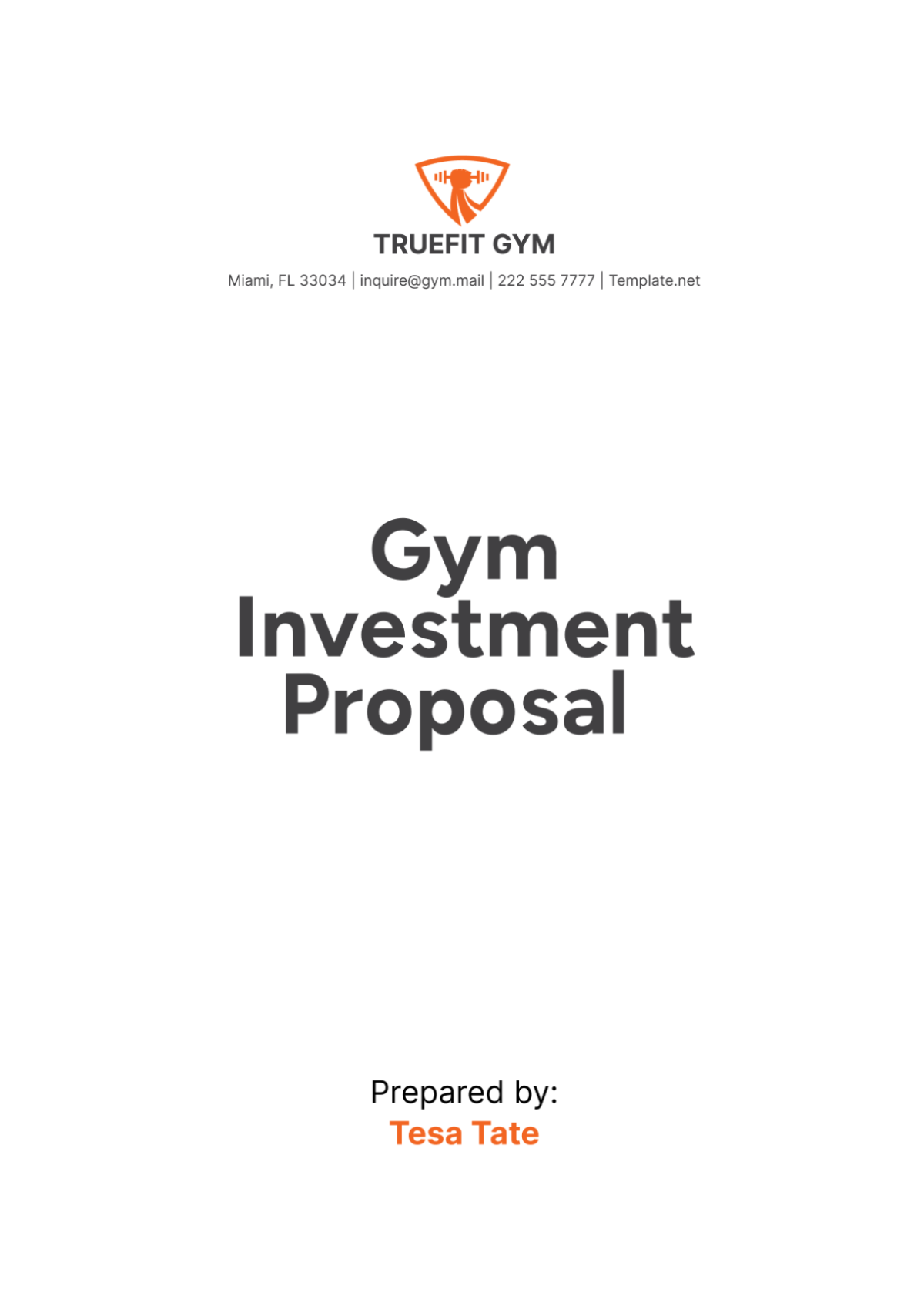
I. Executive Summary
A. Business Overview
[Your Company Name] is a forward-thinking fitness enterprise dedicated to promoting health and wellness through innovative and personalized fitness solutions. With a strong emphasis on community, state-of-the-art equipment, and expert training staff, we aim to provide a comprehensive fitness experience that caters to a diverse clientele. Our mission is to empower individuals to lead healthier lives through accessible, engaging, and effective fitness programs.
B. Mission and Vision Statements
Our mission is to transform lives by fostering a supportive and motivating environment where individuals can achieve their fitness goals. We envision a world where everyone has the opportunity and resources to lead a healthy lifestyle. Our commitment to excellence and continuous improvement drives us to offer superior services that inspire and enable our members to thrive.
C. Overview of the Proposed Gym Project
A new proposed gym project aims to establish a premium fitness center in a strategic location within the city. This facility will feature cutting-edge equipment, a variety of fitness classes, personal training services, and wellness programs. By leveraging the latest fitness trends and technology, we plan to create a dynamic and inclusive environment that appeals to a broad demographic. The gym will also offer ancillary services such as nutrition counseling and wellness workshops to provide a holistic approach to health and fitness.
D. Investment Opportunity
Summary of Investment Requirements
To realize this vision, we are seeking an investment of $1.5 million. This capital will be allocated towards the acquisition of prime real estate, renovation and outfitting of the facility, purchase of top-tier equipment, and initial operational costs. Detailed financial projections indicate a robust return on investment, making this an attractive opportunity for investors.
Expected Returns on Investment (ROI)
Based on our financial analysis, we project a return on investment of 25% within the first three years. The gym is expected to reach operational profitability within the first year, with revenues growing steadily as membership increases and additional services are introduced. Investors can expect a steady stream of income through dividends and the potential for capital gains as the business expands.
Key Milestones and Timeline
The project timeline includes several key milestones:
Month 1-3: | Securing funding and finalizing the lease agreement. |
Month 4-6: | Facility renovation and equipment installation. |
Month 7: | Recruitment and training of staff. |
Month 8: | Pre-opening marketing campaign. |
Month 9: | Grand opening and commencement of operations. |
II. Market Analysis
A. Industry Overview
Current Trends in the Fitness Industry
The fitness industry is experiencing significant growth, driven by increasing health awareness and the rising prevalence of lifestyle-related diseases. Technological advancements, such as fitness apps and wearable devices, are transforming how people approach fitness, making it more personalized and accessible. The demand for specialized fitness services, including high-intensity interval training (HIIT), yoga, and functional training, is also on the rise.
Market Growth and Future Projections
According to market research, the global fitness industry is expected to grow at a compound annual growth rate (CAGR) of 7.8% from [Year] to [Year]. This growth is fueled by a growing consumer base that values health and fitness, coupled with innovations in fitness technology and services. The local market mirrors this global trend, with an increasing number of individuals seeking comprehensive fitness solutions.
B. Target Market
Demographics and Psychographics
Our target market comprises individuals aged 18-55, including young professionals, fitness enthusiasts, and families. These individuals are health-conscious, tech-savvy, and value high-quality fitness experiences. Psychographically, they are motivated by a desire to improve their health, manage stress, and achieve personal fitness goals.
Market Needs and Preferences
The target market seeks convenient and accessible fitness options that offer a variety of classes and personalized training programs. They prefer facilities that provide a clean, modern, and welcoming environment with advanced equipment. Additionally, there is a growing demand for holistic wellness services, such as nutrition counseling and stress management programs.
Competitive Analysis
The fitness industry is competitive, with several established players and boutique gyms in the area. However, [Your Company Name] differentiates itself through its comprehensive service offerings, superior customer experience, and strategic use of technology. By providing a one-stop shop for all fitness and wellness needs, we can attract and retain a loyal customer base.
C. Market Potential
Market Size and Potential for Growth
The local market has a significant potential for growth, with an estimated market size of $50 million. The increasing demand for fitness and wellness services presents an opportunity for [Your Company Name] to capture a substantial market share. Our unique value proposition and strategic marketing efforts will enable us to tap into this growing market effectively.
SWOT Analysis (Strengths, Weaknesses, Opportunities, Threats)
Strengths | Weaknesses |
|---|---|
Comprehensive service offerings | High initial capital investment |
Experienced management team | Dependence on market conditions |
Strategic use of technology | Potential for high operational costs |
Prime location |
Opportunities | Threats |
|---|---|
Growing health awareness | Intense competition |
Technological advancements | Economic downturns |
Expanding market size | Changing consumer preferences |
III. Business Model
A. Services Offered
Membership Plans
We will offer flexible membership plans, including monthly, quarterly, and annual options. Each plan will provide access to all gym facilities, group fitness classes, and select wellness programs. Members will also have the option to upgrade to premium plans that include additional services such as personal training and exclusive classes.
Personal Training Services
Personal training services will be a cornerstone of our offerings. Our certified trainers will design customized workout plans tailored to individual fitness goals and needs. This personalized approach ensures effective results and enhances member satisfaction.
Group Fitness Classes
Our group fitness classes will cater to various interests and fitness levels. Classes will include yoga, pilates, HIIT, Zumba, and strength training. These classes provide a community feel and encourage member engagement and retention.
B. Revenue Streams
Membership Fees
Membership fees will be the primary revenue stream, contributing significantly to our income. By offering various membership plans, we can cater to different market segments and maximize revenue.
Personal Training Fees
Personal training services will generate substantial revenue, given the growing demand for personalized fitness solutions. Offering package deals and loyalty discounts will encourage members to utilize these services regularly.
Class Fees
While many group classes will be included in membership plans, we will also offer specialized classes at an additional fee. This approach allows us to cater to niche markets and increase revenue.
Merchandise Sales
We will sell branded merchandise, including gym apparel, accessories, and fitness equipment. Merchandise sales provide an additional revenue stream and enhance brand visibility.
Supplement and Health Product Sales
Selling supplements and health products aligns with our mission to promote holistic wellness. These products will be available in our gym store, providing convenience for our members.
C. Pricing Strategy
Competitive Pricing Analysis
Our pricing strategy will be competitive, ensuring we offer value while maintaining profitability. A thorough analysis of competitor pricing will inform our rates, ensuring they are attractive yet sustainable.
Pricing Structure for Services and Products
The pricing structure will be tiered to cater to various customer segments. Membership plans will range from basic to premium, with corresponding benefits. Personal training and specialized classes will be priced based on the level of expertise and demand. Merchandise and health products will be competitively priced to encourage sales.
IV. Operational Plan
A. Location and Facilities
Selection Criteria for Gym Location
Selecting the right location is critical to our success. The gym will be situated in a high-traffic area with easy access to parking and public transportation. Proximity to residential and commercial areas will ensure a steady flow of potential members.
Facility Layout and Design
The gym will feature a modern and functional layout designed to optimize space and enhance the member experience. The facility will include a reception area, locker rooms, a spacious workout area, studios for group classes, a personal training zone, and a wellness center. High-quality equipment and amenities will ensure member satisfaction.
Equipment and Amenities
We will invest in top-tier fitness equipment, including cardio machines, strength training equipment, and functional fitness tools. Amenities such as a juice bar, lounge area, and Wi-Fi access will enhance the overall member experience.
B. Staffing Plan
Organizational Structure
The gym’s organizational structure will include management, administrative staff, fitness trainers, and support staff. A clear hierarchy and defined roles will ensure smooth operations and effective communication.
Roles and Responsibilities
Management will oversee daily operations, strategic planning, and financial management. Administrative staff will handle member services, billing, and scheduling. Fitness trainers will conduct classes, personal training sessions, and member assessments. Support staff will maintain facility cleanliness and provide assistance as needed.
Recruitment and Training Plans
We will implement a rigorous recruitment process to hire qualified and experienced staff. Ongoing training and professional development will ensure staff remain knowledgeable and motivated. A focus on customer service and member engagement will be integral to our training programs.
C. Technology and Systems
Member Management Software
We will utilize advanced member management software to streamline operations. This software will handle membership registrations, billing, scheduling, and member communications. It will also provide data analytics to inform business decisions.
Financial and Accounting Systems
Robust financial and accounting systems will ensure accurate tracking of revenues, expenses, and financial performance. These systems will support budgeting, forecasting, and financial reporting.
Marketing and Customer Engagement Tools
Digital marketing tools and customer engagement platforms will be used to attract and retain members. Social media, email marketing, and a user-friendly website will enhance our online presence and member communication.
V. Marketing and Sales Strategy
A. Marketing Plan
Branding and Positioning
Our branding strategy will position [Your Company Name] as a leader in the fitness industry, known for quality and innovation. A strong brand identity, including a memorable logo and consistent messaging, will enhance brand recognition and loyalty.
Marketing Channels
A multi-channel marketing approach will be employed, leveraging digital marketing, social media, traditional advertising, and public relations. Collaborations with local businesses and influencers will expand our reach and attract diverse clientele.
Promotional Strategies and Campaigns
Promotional campaigns will include introductory offers, referral programs, and seasonal discounts. Special events and open house days will attract potential members and create buzz around the gym. Consistent and targeted marketing efforts will drive membership growth and retention.
B. Sales Strategy
Membership Sales Approach
Our sales approach will be member-centric, focusing on understanding individual needs and offering tailored solutions. A seamless and personalized sales process will ensure a high conversion rate from leads to members.
Lead Generation and Conversion
Lead generation will be driven by online and offline marketing efforts. A CRM system will track leads and manage follow-ups. Conversion strategies will include trial memberships, personalized tours, and consultative selling techniques.
Retention Strategies
Retention strategies will focus on member engagement, satisfaction, and community building. Regular feedback collection, loyalty programs, and member appreciation events will foster a sense of belonging and encourage long-term commitment.
VI. Financial Plan
A. Start-Up Costs
The initial investment of $1.5 million will cover:
Lease and Renovation: $500,000
Equipment Purchase: $400,000
Marketing and Branding: $100,000
Staff Recruitment and Training: $100,000
Operational Costs (first 6 months): $300,000
Contingency Fund: $100,000
Funding Sources and Allocation
Funding will be sourced from a combination of investor contributions, bank loans, and potential grants. The allocation of funds will be meticulously planned to ensure efficient use and maximize ROI.
B. Financial Projections
Revenue Projections (1 Year, 3 Years, 5 Years)
Year | Revenue | Expenses | Profit |
|---|---|---|---|
Year 1 | $1,200,000 | $900,000 | $300,000 |
Year 3 | $1,800,000 | $1,200,000 | $600,000 |
Year 5 | $2,500,000 | $1,500,000 | $1,000,000 |
Expense Projections
Expenses will include rent, utilities, salaries, marketing, equipment maintenance, and miscellaneous operational costs. Regular financial reviews will ensure cost control and operational efficiency.
Profit and Loss Statements
Detailed profit and loss statements will be prepared monthly, quarterly, and annually to monitor financial performance. These statements will inform strategic decisions and ensure financial health.
Cash Flow Analysis
Cash flow analysis will ensure adequate liquidity to meet operational needs and investment opportunities. A positive cash flow will be maintained through effective revenue management and expense control.
Break-Even Analysis
The break-even point is projected to be reached within the first year of operations. This analysis will guide pricing strategies and operational planning.
C. ROI and Exit Strategy
Expected Returns on Investment
Investors can expect a 25% ROI within three years, driven by steady revenue growth and efficient operations. Regular dividends will be paid out from the profits.
Timeline for ROI
The projected timeline for achieving ROI is three years, with profitability expected within the first year. This timeline will be closely monitored and adjusted as necessary.
Potential Exit Strategies for Investors
Potential exit strategies include selling the business to a strategic buyer, merging with a larger fitness chain, or going public. These options will be explored as the business grows and matures.
VII. Risk Management
A. Risk Assessment
Identification of Potential Risks
Potential risks include market competition, economic downturns, operational challenges, and changes in consumer preferences. These risks can impact revenue and profitability if not effectively managed.
Risk Impact and Likelihood Analysis
Risk | Impact | Likelihood |
|---|---|---|
Market Competition | High | High |
Economic Downturns | Medium | Medium |
Operational Challenges | Medium | Medium |
Consumer Preferences | Low | Medium |
B. Mitigation Strategies
Strategies to Mitigate Identified Risks
To mitigate market competition, we will continuously innovate and enhance our services. Economic downturns will be managed by maintaining a flexible cost structure. Operational challenges will be addressed through efficient management and staff training. Changing consumer preferences will be monitored through regular market research.
Contingency Plans
Contingency plans will include maintaining a reserve fund, diversifying revenue streams, and developing strategic partnerships. These plans will ensure business continuity and resilience in the face of unforeseen challenges.
VIII. Conclusion
A. Summary of Proposal
Recap of Key Points
This proposal outlines the comprehensive plan for establishing a successful gym under [Your Company Name]. With a strategic location, innovative services, and a strong business model, the gym is poised for significant growth and profitability. The detailed financial plan and risk management strategies ensure a robust return on investment for potential investors.
Emphasis on Investment Potential
The investment potential of this project is substantial, with expected returns of 25% within three years. The growing demand for fitness and wellness services, combined with our unique value proposition, makes this an attractive opportunity for investors seeking a profitable venture.
B. Call to Action
Invitation for Investor Questions and Discussions
We invite interested investors to reach out with any questions and discuss the details of this proposal further. Our team is ready to provide additional information and address any concerns to facilitate informed investment decisions.
Next Steps and Contact Information
To proceed with this investment opportunity, please contact our investment liaison at [Your Company Email] or [Your Company Number]. We look forward to partnering with you to make this vision a reality and achieve mutual success.
- 100% Customizable, free editor
- Access 1 Million+ Templates, photo’s & graphics
- Download or share as a template
- Click and replace photos, graphics, text, backgrounds
- Resize, crop, AI write & more
- Access advanced editor
Secure funding with Template.net's customizable and editable Gym Investment Proposal Template. Use the AI Editor Tool to craft professional and compelling investment proposals. Ensure clear and structured presentations to attract potential investors, enhancing your gym’s financial prospects with this comprehensive and user-friendly template.
You may also like
- Business Proposal
- Research Proposal
- Proposal Request
- Project Proposal
- Grant Proposal
- Photography Proposal
- Job Proposal
- Budget Proposal
- Marketing Proposal
- Branding Proposal
- Advertising Proposal
- Sales Proposal
- Startup Proposal
- Event Proposal
- Creative Proposal
- Restaurant Proposal
- Blank Proposal
- One Page Proposal
- Proposal Report
- IT Proposal
- Non Profit Proposal
- Training Proposal
- Construction Proposal
- School Proposal
- Cleaning Proposal
- Contract Proposal
- HR Proposal
- Travel Agency Proposal
- Small Business Proposal
- Investment Proposal
- Bid Proposal
- Retail Business Proposal
- Sponsorship Proposal
- Academic Proposal
- Partnership Proposal
- Work Proposal
- Agency Proposal
- University Proposal
- Accounting Proposal
- Real Estate Proposal
- Hotel Proposal
- Product Proposal
- Advertising Agency Proposal
- Development Proposal
- Loan Proposal
- Website Proposal
- Nursing Home Proposal
- Financial Proposal
- Salon Proposal
- Freelancer Proposal
- Funding Proposal
- Work from Home Proposal
- Company Proposal
- Consulting Proposal
- Educational Proposal
- Construction Bid Proposal
- Interior Design Proposal
- New Product Proposal
- Sports Proposal
- Corporate Proposal
- Food Proposal
- Property Proposal
- Maintenance Proposal
- Purchase Proposal
- Rental Proposal
- Recruitment Proposal
- Social Media Proposal
- Travel Proposal
- Trip Proposal
- Software Proposal
- Conference Proposal
- Graphic Design Proposal
- Law Firm Proposal
- Medical Proposal
- Music Proposal
- Pricing Proposal
- SEO Proposal
- Strategy Proposal
- Technical Proposal
- Coaching Proposal
- Ecommerce Proposal
- Fundraising Proposal
- Landscaping Proposal
- Charity Proposal
- Contractor Proposal
- Exhibition Proposal
- Art Proposal
- Mobile Proposal
- Equipment Proposal
- Student Proposal
- Engineering Proposal
- Business Proposal

